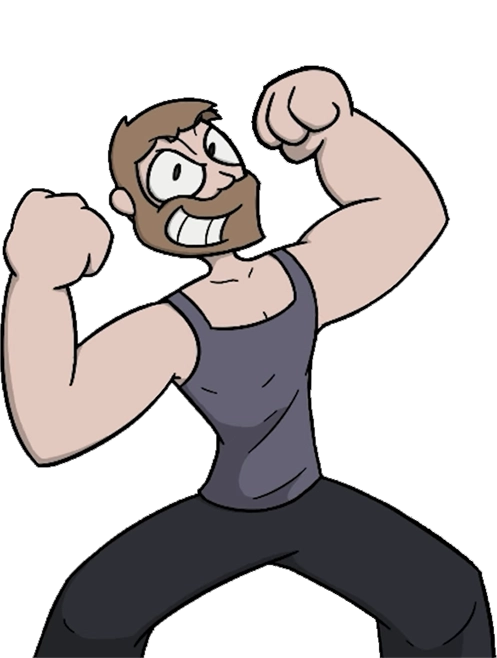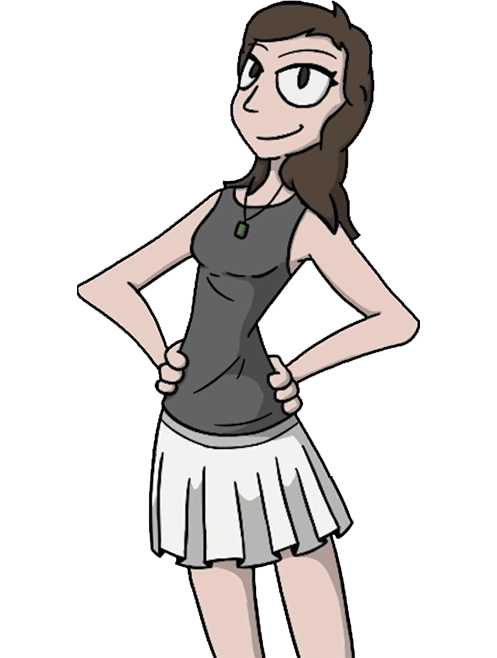My Recollection
Dog vision. Lisa mump cheeks. PULL THE BLOODY CHAIN, BOY!
I’ve always been more of a cat person. They are largely independent, I can efficiently rub an entire one with a single hand, and they are technically a fluid. A dog is a brick of clumsy catastrophe that carries a level of responsibility that borders on child. If you don’t know where your dog is, that’s a problem. I don’t know where my cat is right now and there’s a chance she’s in the room with me. But in the feral suburbs, you needed some kind of dog or there’d just be people in your yard sometimes. The dog we got was a good dog because she was neutered. In nearly every other example I had, “being a dog person” translated to “enjoying spending time with a hairy rapist” because nobody could afford neutering when the price of speed just went up.
The first dog rape I saw was a kind of basic Weinstein, not rape-rape but only because the implied threat made further force unnecessary. A neighbour of ours had a giant trampoline, one that could dangerously fit eight to twelve 8-12-year olds, so we all congregated there after school. They had a horse in a dog mask they called Rat. This dog was big enough to hide Greeks in and anime characters tried to ride it. Woofs came from so deep within this colossus that most of the party were dead by the time it reached the mouth, so the only sound it ever made was the kind of flaccid murmur a sleepy dad makes sitting down. This was still the most personality it exhibited as it otherwise spent its time in as much motion as Hanna-Barbera background art.
Except this one time.
The 8-12 eight to twelve-year olds sitting on the trampoline weren’t scared of Rat exactly but we all still maintained a basic human wariness of anything that could swallow us whole, so tensions rose when Rat wandered up to the side of the trampoline. “It’s fine”, said the 8-year-old brother who lived there. It may well have been “fine” but we all still bailed when rat jumped up onto the trampoline, leaving only the brother professing the fineness of things.
There’s something fundamentally wrong about a dog on a trampoline. It’s like seeing a really old person in a bouncy castle. Technically it’s all soft and springy but the subject is so wooden and confused by the situation that you can’t help but expect tragedy. We didn’t get tragedy, exactly. Rat awkwardly walked over to where it was “fine” and half slumped his rear against the 8 year old brother.
Here’s the thing about a dog dick: It looks like someone circumcised a regular dick all the way to and around the balls. There’s a moment of confusion for a bunch of kids when what looks like a condom full of berry smoothie flops over the shoulder of a child. Is it hurt? Are those intestines? How has the Fine Brother not noticed this yet?
Once the puzzle pieces fall into place, that a dog dick just looks like a 5-year-old drew it and Clive Barker coloured it in, giggles started to spread. There’s a dog dick on someone’s shoulder and for a cluster of creatures driven by social instinct to exclude and mock people for any little thing, being caressed by a raw dog boner is like winning the little cunt lottery. You are gay now. Like, gay gay. You are touching a dick. It doesn’t matter if it’s a dog dick, that just makes you dog-gay which is even better. Ha, gay.
There’s an image burned in my head I wish I could have printed out and it’s the Fine Brother looking to his left and having his nose be about a centimetre away from the ruptured beetroot of turgid dog wang. I don’t know what dog dicks smell like and I’m proud of that. The Fine Brother knows and that’s something he will have to take to his grave. Now his pieces are clicking into place. He is touching a dog penis in front of the peer group who have figured this out before him and are mocking him accordingly. Had it just brushed against him, there wouldn’t have been that big a deal made, but it took him so long to realize and there’s just no comeback for being seen luxuriating under a veiny dog cock.
He instinctively turned his head before he screamed as anything else would have invited penis into mouth. This was good, as if you accidentally suck a dog dick in the outer suburbs then you may as well change your name and move. Nobody will ever let you live that down. But as he reacts and starts to move, so does Rat. As much as the Fine Brother wants this to be over, Rat does not want this to be over and he outweighs the shrieking, dog-gay 8-year-old by a bit.
So Rat just sits his hips down on the Fine Brother and smooshes his inside out dick looking dick onto the screaming child’s face. The jeering chorus of feral chimps hears his cries muffled by gay dog penis and goes mental. The Fine Brother kicks about but is in kind of a bind. Struggling to escape from Beneath the Planet of the Dog Penis means moving back and forth a bit to worm his way out. This means rubbing back and forth on the dog penis which means you are wanking a dog with your face. Being molested by a giant dog is one kind of gay but gaying the gay dog back is, like, turbo-gay. You may as well come out that you are gay for dog dicks because we all know you are. So the Fine Brother kicks and thrashes but mostly ineffectively. This goes on for what was probably only a few seconds but, like dog years, dog penis to face years are 7-10 times the length so it felt like forever.
Amidst all this, Rat looks out onto the world like a stroke victim looks out a window. I don’t know what a dog orgasm face looks like but I still assume it’s a face. I’ve seen dogs make faces at things that are tasty or fun, so they must have a face for when they rub their bloated gummi-worm hog on an 8-year-old boy’s smooth face. It’s possible Rat was making a face but it was buried beneath the beast’s immobile crust.
Either way, it’s impassive Moai stare as it didn’t even enjoy face-raping a squirming, screaming 8-year-old is an image that pops into my head whenever someone says they’re a dog person.
The Episode.
Settings are one of the core structural elements of a show and will dictate later plot and character possibilities. A family show means there are characters of different ages and these will occupy both shared and individual locations. Start in the home and the episode can be focused on anyone. Start at the Plant and the scene’s about Homer. Start at the school and it’s about Bart or Lisa (and others later on). Bart and Lisa can’t just be at the Plant any more than Homer can be at the school, so making this happen requires work by the narrative.
This work will both take up space and require some level of logic, which means Homer being at the school can’t just be there untethered, if he’s there he’s being summoned and if he’s being summoned there’s a reason. All of this creates expectations in the audience and takes up time, meaning it will subsequently be part of a large plot element. See Bart’s school trip to the Plant or any episode where Homer and Marge have a school meeting about Bart. As these logical steps and plot elements pile up, you run out of space for your actual story.
A lot of shows get around this problem with tight focus, either character or setting, with these foci tending to be split along the lines of drama for the former and everything else for the latter. Shows like Cheers that are set in a single location have the benefit of the built-in understandings that a known social setting, like a bar, create. Without having to spend any narrative time or energy there’s a premade cast of mains for focal stories, and goofy side-characters ready for whatever comic relief or surprising depth you feel like rolling out. As the settings of shows like this and The Office can focus without excluding, characters can grow without disrupting the show’s core reality.
Archer started with a well utilised audience knowledge of spy tropes to give themselves freedom with settings and events, allowing for quite absurd plots and events to exist comfortably within an otherwise fairly real world. But as the side characters grew into more important parts of an ensemble, the show got kind of stuck. Doing focal episodes means ignoring characters that may have grown into fan favourites. Archer did this for a while but soon fell into the trap of coming up with contrived reasons for all the characters to be in the same setting, even if no real-world logic, or even the show’s looser approximation, supports them all being there. They eventually committed the worst of all sins, making awful jokes about how contrived their own writing is which is insulting to the viewer and actively destructive to the show’s story world.
The Simpsons exists in a floppier version of reality, one more distinctly cartoony than even Archer, so it never needed to hold itself to higher standards. That it did was one of its defining characteristics and part of what made the show’s peak period so good. Because the final way that one can have a bunch of separate plots and characters work together is the hardest and it’s the one Bart’s Dog gets an F chooses. Coming up with a good narrative reason to have all these different characters and spaces meaningfully connect in a logical fashion is hard because there’re just fewer that exist within reality. It even goes one notch cleverer and chooses to focus on the dog.
Had the show focused on Bart, which it easily could have, the show would have been a character focal one that would have had to make choices about what to ignore as Bart’s perspective, behaviour, and feelings require narrative real estate. By focusing on Santa’s Little Helper, the narrative gets the benefit of a perspective that exists primarily through the experiences of the surrounding humans.
The result is an episode that perfectly executes the complex braiding I’ve spoken about, and through that we get several characters at once.
Homer has the lightest elements, but this just reflects his already well-established character. Homer is a sad man, unhappy and only just smart enough to be tortured by that. He desperately grabs at little things to make him happy because he’s too scared to hope for more, so the base marketing of things like sneakers and cookies is beyond his capacity to resist. Happy people own impressive sneakers. Big cookies are a lot of a good thing. It’s typically treated as a moral failing ripe for mockery, and his breaking apart at the loss of a $5 cookie is a good example of that, but when small things can break a person, that person was already close to the edge.
Lisa’s story exists as a kind of adjunct to her mother’s surprisingly stronger one. Her intelligence alienates her from both parents, Homer is a dumb oaf and Marge is a spineless sponge, so her shared episodes with them typically focus on her learning about some deeper level of connection. Though otherwise close to her mother, Lisa sees her and her hobbies as quaintly dumb at best. The quilt, and her mother’s impressive skills relating to it, are that deeper connection. A fact emphasised by Lisa starting a new one at the episode’s close.
Bart has more a functional role in the plot as the primary advocate for his dog and, along with Lisa, the necessary counterpoint to Homer and Marge over the dog’s fate. Bart is a bit like Homer in that his position as source of conflict and wacky events leaves him with a lot of negative personality traits. Occasionally we get a look into the kinds of childhood anxieties and fears that cause these, ones that would be present in a child of a high-stress household, but he’s mostly an unthinking, selfish piece of shit. As such, he’s given only a few basic redeeming core traits. In this case: loyalty.
Loyalty is the participation trophy of positive core characteristics. Thugs, gangsters, and various otherwise irredeemable pieces of shit will, even consciously, cling to loyalty as though it redeems the rest of their miserable personality. Many modern dramas, like The Sopranos will have and take the time to give their pieces of shit more depth, but the loyalty card remains a popular trope. Bart gets it because giving him anything else would force some kind of internal conflict or change.
But it’s Marge who really stands out in this episode, even if it’s mostly because the bar she’s trying to clear is so low. As the straight character, she’s burdened with being the nagging voice of dissent to every shenanigan her husband or children get into and what character moments aren’t that are usually naff mum hobbies we make fun of. Most of her character episodes are simply inversions of that, her snapping and the family having to deal with it. But the quilt offers her something new.
When threading the needle, Marge’s skill in sewing is treated with respect, and her burning her callus makes it cool. Later Marge moments, like the loom, are mocked because it’s a defunct skill. The loom is merely a surpassed technology. The quilt is the expression of 6 generations of Marge’s family. An expression that is manifest only through the actual craft. The quilt can never be surpassed by industrial growth as it is its handmade quality that is the point.
The value of this as an addition to her character depth is demonstrated by her rare shift to the technically villainous anti-dog side. Reflecting from her position as the voice of reason, hers is usually the side the narrative takes, and the audience is expected to. This positions her again as a structural component of the narrative and not a character. But Marge loved that quilt, and even though the story is about a dog and even though loyalty is a positive quality she has enough character to hate the dog for destroying it.
Near naturally the story ends on a fairly trite trope, Santa’s Little Helper just miraculously begins to understand Bart. One shouldn’t lean on this too heavily but it’s an otherwise fine narrative device. A bit like hyperdrive, there’s going to be some level of magical bullshit because without that you’re not a writer but the genius who invented hyperdrive. But this is a minor point, the episode itself is peak early Simpsons.
Yours in resisting the beef wellington, Gabriel.
Jokes, lines, and stray thoughts.
Santa’s Little Helper’s (gah, possessives) behaviour is inconsistent with how he is in most of the series, but it’s a dog so I’ll let it slide.
Hibbert seen here in full Cosby. The joke where he asks Marge how she got his home number is a goodun. Similar to jokes where one bleeps an otherwise innocent word, comedy by omission taps into that unconscious aspect where an undefined something will create a stronger emotional response than a known quantity. Horror uses the same technique to scare.
Bart getting stuck in a logic loop is another fun little one because it’s so real.
I’m assuming Nev-R-Break also make the tubes on the Springfield Monorail.
Homer on the phone to Mrs Winfield is a good example of how to use build to make a joke work where the audience already knows the punchline. It’s a great performance by Castellaneta. His little exhalation of rage and his slow walk toward where we know the dog isn’t, punctuating each step with yet another nail in his own coffin, shifts the absurdity from the dog not being there to Homer making it worse for himself. These little shifts within a joke or joke construct are great ways to breathe new life into old gags or to nest more jokes within each other.
Ned walks away in this scene so terribly it’s something I noticed even as a child. It feels a bit like how some cartoons will design characters only to realise that the animation style makes certain shots wildly unworkable.
The mouth interior shot with Hibbert is a goodun. One of those little things where the animators remember they don’t have the barriers of live action.

Teen… STEAM? There’s a dumb teenybopper aspect of Lisa that’s always kind of there but clashes a bit with the rest of her nerd/outcast characteristic. It’s not to say the two can’t blend in certain ways, but Lisa’s aren’t the nerd teenybopper crap. Though this is largely because the early 90s didn’t really have the kinds of cultural fusions common to today.
Babysitter bandit cameo is a nice one as it speaks to the greater lore of the show. The channel flipping also gives us a rare look at a non-Hartman Troy McClure with a great line about white eyeballs. Nicely ridiculous but edging on the believable.
There’s another element of classic Simpsons here and that’s a solid guest character. Tracy Ullman is in quality form as Winthrop. Simpsons guest characters tend to alternate between comic, like Winthrop, and dramatic ones, like Mr Bergstrom. Each exists within the general trope functions of their respective narrative dimensions. The wacky characters can pop in and out fairly easily, whereas the dramatic tend to need the support of more narrative time to work. Winthrop is a maniacal presence, a demented Thatcher-like authoritarian, but her absurdity works because she requires no more framing than “dog trainer” which subsequent years of reality programming have proven to be, if anything, an understated performance.
Characters like Winthrop, who border on antagonist, typically get some kind of comeuppance or challenge to their worldview. She doesn’t, she just respects that Santa’s Little Helper passed his tests. It’s a bit of nuance that few bother with.
Homer dancing at the kids when Marge agrees with him is classic.
“People think only mules can pull carts” is a great gag as it suggests a stranger reality behind the line.
PULL THE BLOODY CHAIN, BOY
The frisbee bouncing off of the dog’s vacant eyes is a great visual gag.






6 replies to Bart’s Dog Gets an F
Alex on 27th January 201927 Jan 19 said:
Fun fact: Rottweillers were bred to pull carts. I'm not sure if this is part of the farmer's gag, but either way it works.
Great episode from a narrative perspective, on rewatch I realised how much the early events of the episode are interlinked. Lisa getting sick indirectly leads to the shared grief around the destruction of the blanket, shoes and cookie. Almost a seamless way to give everyone a part to play when it comes to dealing with the dog.
Unrelated note but I'm a dog person because my mother and I are both allergic to cats, and so our family has always had dogs. There was only ever one that constantly tried to hump my back if I sat down near them, and she was a girl. I'm glad I've never had the lipstick applied, as it were, that intro story deserves a standing ovation.
Gabriel on 27th January 201927 Jan 19 said:
Well I'll be goddamned, they DO pull carts. And people still do this! That's nuts.
Petey on 27th January 201927 Jan 19 said:
I recall Winthrop being based on Barbara Woodhouse, a dog trainer from some British 80's show, not unlike Ceaser Milan's stuff if it was made about 30 years ago. I've personally never seen it myself but yeah Winthrop's mannerisms in this episode cracked me up something fierce as a kid.
Tangentially related, I remember Roger Moore in Octopussy telling a tiger to "Ssssit!" in the same dog trainer fashion that made me laugh all the same.
Gabriel on 28th January 201928 Jan 19 said:
My suspicion is that she's still more based on Thatcher than Woodhouse. I've seen bits of her stuff and watched some a moment ago, similar in fashion but not character. But yeah, she looks like a loon in this episode but, Christ, the dog nanny lady outdoes her.
Magnumweight on 28th January 201928 Jan 19 said:
"Eight to twelve 8-12-year olds" lines are some of my favorites from you, can't really articulate why but it brings me joy.
I, too, am a cat person but I'd give actual money for the lumps to sometimes understand certain commands like "Get the hell off my laptop!"
Things bouncing off a deadpan/unchanging face never ceases to make me laugh. Variants such as the one in Homer at the Bat where the effects take a second to register are also a favorite.
Gabriel on 28th January 201928 Jan 19 said:
Yeah, delayed and null response to physical pain is funny, stuff hitting the face particularly.
Comment on Bart’s Dog Gets an F
To reply, please Log in